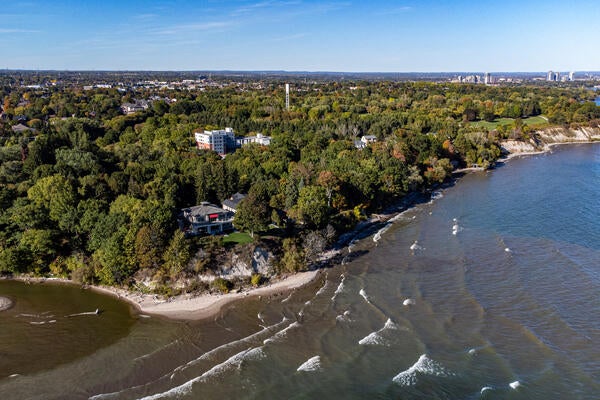
A new study shows international students are not to blame for the housing crisis
Waterloo researchers debunk myths about international students and show that they are a vulnerable population impacted by Canada's housing crisis

Waterloo researchers debunk myths about international students and show that they are a vulnerable population impacted by Canada's housing crisis
By Chantal Vallis Faculty of EnvironmentThere have been ongoing accusations that international students are flooding university towns and taking up all the affordable housing. These narratives paint international students as the culprit, but a new study affirms that there is no basis for blaming international students for Canada’s housing crisis and looks to change the narrative.
The study was led by a team of researchers at the University of Waterloo’s Faculty of Environment and debunks popular myths about international students. For example, international students are often perceived as temporary visitors who are young, hyper mobile and care-free individuals. While some may fit this demographic, the researchers point out that the reality is much different. Currently, one in five international students is estimated to live with their partner and children during their study, and these families are overlooked in Canada’s policy and planning in higher education, migration and housing.
“The needs of international student families haven’t really been discussed,” says Dr. Alkim Karaagac, researcher in the Department of Geography and Environmental Management and principal investigator of the new study. “There is an invisibility and silence, which is a perfect recipe for vulnerability and exploitation.”
Focusing on this vulnerable population, the researchers conducted a two-year case study on the housing experiences of 21 international student families living off-campus in the Waterloo region. The region is a unique location to investigate given it has the largest purpose-built student housing market in the country and is reported to have one of the least affordable housing markets among Canadian university towns. Their interviews centered the lived experiences of international students making a home in Canada and the challenges they face in the housing market. The findings suggest that all international student families face many hurdles to finding adequate housing, plus there are not enough diverse options to fit their needs.
During the interviews, the researchers used a method called mental sketch mapping to invite young participants to contribute to the conversation through drawings/paintings/sketches of their rooms, homes, streets and neighbourhoods. As the interviews continued, they asked children prompt questions to find out the story behind the drawings, what home meant to them and how children relate to those places.
“We talked to a family who had been living in an Airbnb for the last eight months who used up all their savings on tuition and housing,” Karaagac says. “While the Airbnb is expensive, when you settle somewhere and the kids start school, you cannot just move somewhere else. Especially when there aren’t a lot of options.”
Other countries don’t share these problems. Subsequent interviews with experts that can speak to the housing crisis detailed how the United States and United Kingdom support their international students with subsidized housing. From these conversations, plus a review of government documents and reports, Karaagac and her team put forward a series of recommendations.
“We don’t have to wait years for major policy changes. There are small changes that we can make now to have a positive impact. One thing is that international students should receive accurate information on university housing, waiting lists, cost of living and housing in the local context. They also need hands-on support when applying for housing, so they don’t fall victim to fraud, and help upon arrival as they navigate their first week,” Karaagac says.
The researchers believe these short-term actions can be complemented by longer term actions, such as implementing polices and bylaws that curb rental scams and discrimination by property owners. They also share that creating partnerships with housing market actors can lead to creative affordable housing solutions and that it is essential to expand how universities in towns can be more interconnected with town centres.
At Waterloo, international students comprise 41 per cent of our total graduate student body. Developing solutions within the institution and with partners to improve the graduate student housing experience is a key area of focus. For example, the Graduate Student Association, a key project partner, is using the findings to propel their advocacy work for affordable housing in the region and recently held an event with international student families. Moving forward, they would like to continue creating events to bring together international student families and share resources and programs available within the region.
Later this year, Karaagac and the team will be presenting their findings and recommendations with actors in the community. They are also scheduled to present at conferences held by the Canadian Association of Geographers and British Association of Geographers.
“We need to see international students as complex and more than one type of student. They are a diverse group which you can’t house in a standard dormitory. We need to step up and be prepared as towns, universities and provinces to support them.”
The study, Learning from International Student Families, Making a Home in Canada, was supported by the Social Sciences and Humanities Research Council of Canada Insight Development Grant.

Canada's coasts face increasing flooding and erosion with climate change.
Read more
Canada must act to protect the longest marine and freshwater coastlines in the world from the surge of climate change

Read more
Waterloo researchers are helping shape the next global scientific assessment that will guide world leaders from climate promises to action

The authors of a new study examined the U.S. economy and estimates of the use of artificial intelligence in industry to determine the environmental impact of AI adoption. (Illustration generated by Gemini/Google on November 10, 2025.)
Read more
Energy consumption in the U.S. shifts perception of the environmental risks of AI
The University of Waterloo acknowledges that much of our work takes place on the traditional territory of the Neutral, Anishinaabeg, and Haudenosaunee peoples. Our main campus is situated on the Haldimand Tract, the land granted to the Six Nations that includes six miles on each side of the Grand River. Our active work toward reconciliation takes place across our campuses through research, learning, teaching, and community building, and is co-ordinated within the Office of Indigenous Relations.